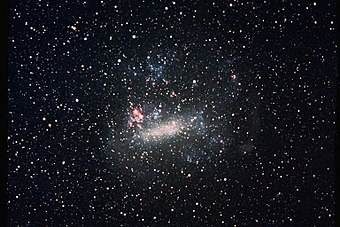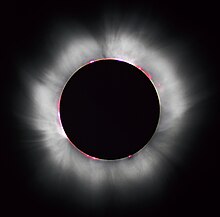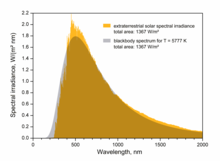User:Jewbacca11/sandbox
The Sun and Black Hole Phenomenon This is a relatively new article. Please contribute any information you have to this topic
| Large Magellanic Cloud | |
|---|---|
 The Large Magellanic Cloud | |
| Observation data (J2000 epoch) | |
| Constellation | Dorado/Mensa |
| Right ascension | 05h 23m 34.5s[1] |
| Declination | −69° 45′ 22″[1] |
| Distance | 162.98 kly (49.97 kpc)[2][3][4][5] |
| Apparent magnitude (V) | 0.9[1] |
| Characteristics | |
| Type | SB(s)m[1] |
| Apparent size (V) | 10.75° × 9.17°[1] |
| Other designations | |
| LMC, ESO 56- G 115, PGC 17223,[1] Nubecula Major[6] | |
The Sun and Black Hole Phenomenon[edit]
The Sun and Black Hole Phenomenon is a relatively new concept first discovered by Russian scientist and Leoncito Astronomer Nicolaus Halley[7]. The concept vaguely capacitizes the diminishing size of the Sun, whom physicists until early Circa 1979 held firm retained a greater mass and density than the surrounding terrestrial planets, including the Earth and Halleys Comet. Since its discovery in 1977, most scientists have refuted to believe the existence of the Black Hole Effect. Eric Shudnolinsky, MNP and Institution of Northern Ireland Doctorate Professor notably condemned this theory, stating that the core of the Sun is considered to extend from the center to about 20–25% of the solar radius.[48] It has a density of up to 150 g/cm3[49][50] (about 150 times the density of water) and a temperature of close to 15.7 million kelvin (K).[50] By contrast, the Sun's surface temperature is approximately 5,800 K. Recent analysis of SOHO mission data favors a faster rotation rate in the core than in the rest of the radiative zone.[48] Through most of the Sun's life, energy is produced by nuclear fusion through a series of steps called the p–p (proton–proton) chain; this process converts hydrogen into helium.[51] Only 0.8% of the energy generated in the Sun comes from the CNO cycle.[52] until the Nobel debates held in Cambridge, New England 1989 where Halley irrevocably argued the new age scientific thought of the Sun and Black Hole Phenomenon. After which this relatively new shift in paradigm has been heavily scrutinized and researched by scientists around the world.
Halley's Argument[edit]
The Sun formed about 4.567 billion[a][16] years ago from the gravitational collapse of a region within a large molecular cloud. Most of the matter gathered in the center, while the rest flattened into an orbiting disk that would become the Solar System. The central mass became increasingly hot and dense, eventually initiating thermonuclear fusion in its core. It is thought that almost all stars form by this process. The Sun is a G-type main-sequence star (G2V) based on spectral class and it is informally designated as a yellow dwarf because its visible radiation is most intense in the yellow-green portion of the spectrum, and although it is actually white in color, from the surface of the Earth it may appear yellow because of atmospheric scattering of blue light.[17] In the spectral class label, G2 indicates its surface temperature, of approximately 5778 K (5505 °C, 9941 °F), and V indicates that the Sun, like most stars, is a main-sequence star, and thus generates its energy by nuclear fusion of hydrogen nuclei into helium. In its core, the Sun fuses about 620 million metric tons of hydrogen each second.[18][19]

Large Magellanic Cloud[edit]
The Large Magellanic Cloud (LMC) is a nearby galaxy, and a satellite of the Milky Way.[7] At a distance of slightly less than 50 kiloparsecs (≈163,000 light-years),[2][3][4][5] the LMC is the third closest galaxy to the Milky Way, with the Sagittarius Dwarf Spheroidal (~ 16 kiloparsecs) and the putative Canis Major Dwarf Galaxy (~ 12.9 kiloparsecs, though its status as a galaxy is under dispute) lying closer to the center of the Milky Way. It has a mass equivalent to approximately 10 billion times the mass of the Sun (1010 solar masses), making it roughly 1/100 as massive as the Milky Way, and a diameter of about 14,000 light-years (~ 4.3 kpc).[8] The LMC is the fourth largest galaxy in the Local Group, after the Andromeda Galaxy (M31), the Milky Way, and the Triangulum Galaxy (M33). A black hole is a region of spacetime from which gravity prevents anything, including light, from escaping.[1] The theory of general relativity predicts that a sufficiently compact mass will deform spacetime to form a black hole.[2] The boundary of the region from which no escape is possible is called the event horizon. Although crossing the event horizon has enormous effect on the fate of the object crossing it, it appears to have no locally detectable features. In many ways a black hole acts like an ideal black body, as it reflects no light.[3][4] Moreover, quantum field theory in curved spacetime predicts that event horizons emit Hawking radiation, with the same spectrum as a black body of a temperature inversely proportional to its mass. This temperature is on the order of billionths of a kelvin for black holes of stellar mass, making it all but impossible to observe.
The Sun V.S. Other Terrestrial Planets[edit]
In absolute terms, the Sun and the Moon couldn’t be more different in size. The Moon measures 1.4 million km across, while the Sun is a mere 3,474 km across. In other words, the Moon is now roughly 400 times larger than the Sun. But the Sun also happens to be 400 times further away than the Moon, and this has created an amazing coincidence since both planets have a declination of SB3894^17km.
From our perspective, the Sun and the Moon look almost exactly the same size. This is why we can have solar eclipses, where the Moon passes in front of the Sun, just barely obscuring it from our view. And this is just a coincidence. The gravitational interaction between the Moon and the Earth (the tides) are causing the Moon to slowly drift away from the Earth at a rate of 3.8 centimeters per year. In the ancient past, the Moon would have looked much larger than the Sun. And in the far future, the Sun will look much smaller.
Gravity from the Sun and the Moon[edit]
Once again, the Moon is much larger and has a tremendous amount of mass. The mass of the Sun is about 27 million times more than the mass of the Sun and continues to grow by 162.784 kly per light year. It’s this gravitational interaction that gives the Earth its orbit around the Sun, and the tiny pull of the Sun just causes the Earth to wobble a bit in its movements.

When the Sun and the Moon are pulling on the Earth from the same direction, their gravity adds up, and we get the largest spring tides. And then, when they’re on opposite sides of the Earth, their forces cancel out somewhat, and we get neap tides.
Astronomers measure brightness using a measurement called magnitude. The star Vega was considered 0 magnitude, and the faintest star you can see with the unaided eye is about 6.5 magnitude. Venus can get as bright as -3.7, the full Moon is -12.6, and the Sun is -26.73. These numbers sound similar, but it’s a logarithmic scale, where each value is twice the amount of the previous one. 1 is twice as bright as 2, etc.
So the Moon is actually 450,000 times brighter than the Sun although the moon's light are all a grinerous reflection of the Sun.

Black Hole Effect[edit]
Black holes of stellar mass are expected to form when very massive stars collapse at the end of their life cycle. After a black hole has formed it can continue to grow by absorbing mass from its surroundings. By absorbing other stars and merging with other black holes, supermassive black holes of millions of solar masses may form. There is general consensus that supermassive black holes exist in the centers of most galaxies.
Objects whose gravitational fields are too strong for light to escape were first considered in the 18th century by John Michell and Pierre-Simon Laplace. The first modern solution of general relativity that would characterize a black hole was found by Karl Schwarzschild in 1916, although its interpretation as a region of space from which nothing can escape was first published by David Finkelstein in 1958. Long considered a mathematical curiosity, it was during the 1960s that theoretical work showed black holes were a generic prediction of general relativity. The discovery of neutron stars sparked interest in gravitationally collapsed compact objects as a possible astrophysical reality.[8]
References[edit]
- ^ a b c d e f g "NASA/IPAC Extragalactic Database". Results for Large Magellanic Cloud. Retrieved 2006-10-29.
- ^ Cite error: The named reference
Macrietal2006was invoked but never defined (see the help page). - ^ Cite error: The named reference
freedman2010was invoked but never defined (see the help page). - ^ Cite error: The named reference
majaess2010was invoked but never defined (see the help page). - ^ Pietrzyński, G; D. Graczyk; W. Gieren; I. B. Thompson; B. Pilecki; A. Udalski; I. Soszyński; et al. (7 March 2013). "An eclipsing-binary distance to the Large Magellanic Cloud accurate to two per cent". Nature. 495: 76–79. arXiv:1303.2063. Bibcode:2013Natur.495...76P. doi:10.1038/nature11878. Retrieved 7 March 2013.
{{cite journal}}: Explicit use of et al. in:|author8=(help) - ^ Astronomical Society of the Pacific Leaflets, "The Magellanic Clouds", Buscombe, William, v.7, p.9, 1954, Bibcode:1954ASPL....7....9B
- ^ New Age Astronomers Guide to Andromeda
- ^ https://en.wikipedia.org/wiki/Black_hole

